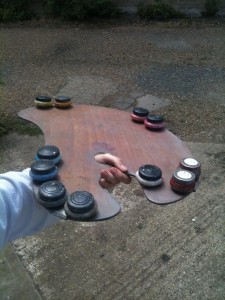My Palette
|
Artists: how do you set up your palette? Non-artists, do you have a painting habit with plates or pots? A few weeks before this post, the Muddy Colours blog asked the audience about their palette choices. I answered, and my comment was eaten by the internet. Here is my explanation of my own palette now I have had long enough to think about what I am doing. Your mileage may vary, and you may measure in kilometres. I work in oil, and that can take an hour to dry to the point of stickiness, in a thin layer. I do not have to worry about my paints drying on the medium or the palette. That means I can use a classic palette with no sumps for water or layers of damp tissue. My medium is oil, which means that a smooth piece of wood is good for my purposes. Once it has been wiped down several times, the oils from the paint form a protective layer. My palette generally sits on a trolley, but I can hold it in my hand if necessary. It is too heavy for me to want to do that all the time. The really important part to me is the paint pots. Two blues, two reds, and two yellows are in places that have become habit to me. Those six colours can let me mix most things, bright or dull, warm or cool, without recourse to more tubes. There is no one way of mixing ‘brown’, because it depends on whether you want a pale pine-coloured yellow brown, or a teakish brown, or aged oak brown. I can manage an approximation of any of those, and one that I can mix consistently. I do need to write down what my mixes are, but I tend to do so, and to take iphone photographs for labelling. The pots are waterproof if held the right way up, which is all I need. At the end of a day’s painting I fill them with water, and the paint, with its heavy pigments, stays at the bottom. Sometimes, particularly with organic colours, that is not successful, and I have to throw away the paint rather than store it. Ivory black, which is made from bone, is very bad for this. Lamp Black, which is largely carbon, is also bad – I have stopped trying to keep blacks out of the tube for more than a couple of days. My palette itself has only been stained with paint once, the first time I used it. I sanded it down with the grain and re-oiled it, and it came up beautifully. It was a lesson to me in looking after my kit, and now I clean it down with a soft cloth and spare medium, or pure turps if the paint has started to dry on it after all. Questions to think about: What materials can you use for a palette? Are tiles too heavy? It there One True Arrangement of paints and media that you use? How do you clean your palette? |
